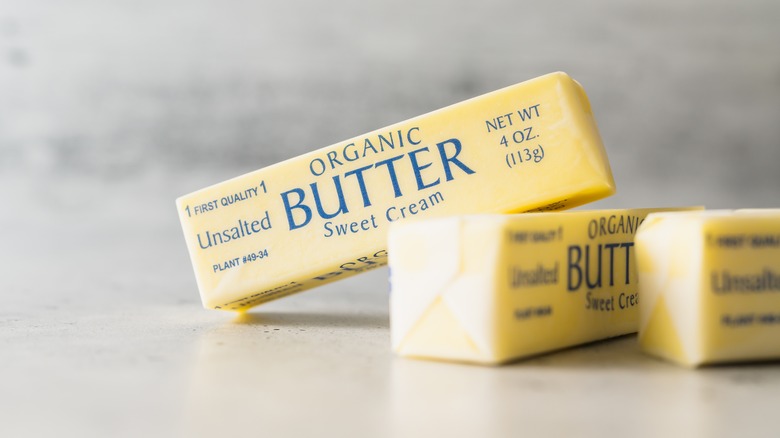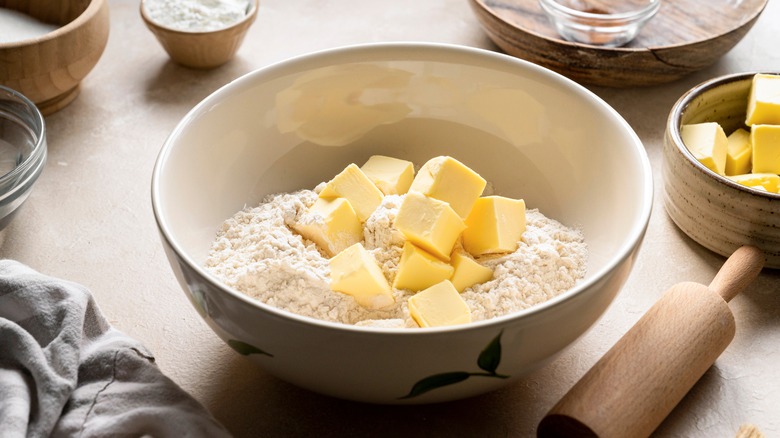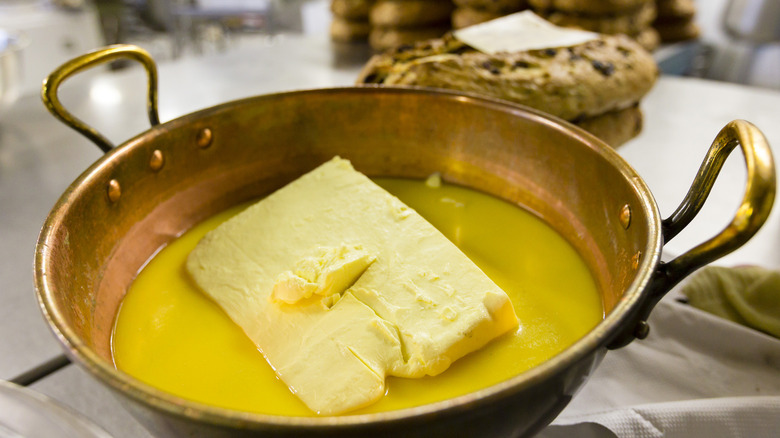Yes, Butter Temperature Actually Matters When It Comes To Baking
There are plenty of ingredients that are safe to substitute when baking like applesauce for eggs or even club soda for baking soda. When it comes to butter, you can usually use margarine in its place, however contrary to what you might assume, you can't use melted, softened, or cold butter interchangeably. While butter in any state introduces fat to baked goods, their different temperatures create different reactions with the ingredients in the batter or dough.
The biggest difference is their ability to trap air. Butter is made up of crystals, and these crystals form a network that can trap air. But once the temperature of butter hits its melting point of 90 to 95 degrees Fahrenheit, its crystalline structure breaks down. This makes it nearly impossible for melted butter to trap air, which ultimately results in a crumb with fewer air pockets. Baked goods made with softened butter therefore tend to be puffier, while those made with cold butter adopt a more flaky texture.
How butter temperature affects gluten formation
In addition to affecting the amount of air in a baked good, the temperature of butter also affects gluten formation. Gluten is what gives baked goods its elasticity, and it develops when the flour is hydrated by a liquid such as milk or water. The more gluten that develops, the chewier a baked good will become, and this can often come down to the temperature of the butter.
When it's melted, butter is able to form a barrier of fat around each flour particle. This effectively prevents the network of gluten from tightening and toughening the dough. Using cold butter also slows gluten formation, however for a different reason. As a solid, it can't fully combine with the flour to create a fat barrier, but it does bring down the temperature of the gluten, thereby slowing down the formation process.
The effects of softened butter on gluten development lie somewhere in between, which explains why it's such a popular choice for baking. At room temperature, butter is not quite cold enough to completely cool down the dough, however, it's still soft enough to coat the flour in fat, yet can still hold plenty of air.
Can you re-solidify melted butter?
If your recipe calls for softened butter, your first thought is probably to zap it in the microwave for a few seconds. Unfortunately, this is an easy way to end up with a pool of melted butter instead. You might think you can just stick it in the fridge and let it re-solidify, but unfortunately, it's not that easy. Melted butter does solidify when its temperature is brought back down to 60 to 65 degrees Fahrenheit, but its crystalline structure has already been broken. That means it'll trap the same amount of air as melted butter, even as a solid.
To return the butter crystals to their original state, the melted butter has to be blast chilled. Since refrigeration is too slow, the best course of action is to mix it with ice as soon as you realize it has melted. The temperature of the butter should immediately jump back down, re-solidifying the butter while repairing the crystalline structure so it can properly function as softened or cold butter. This is all a lot of fuss, but worth it in the end to get baked goods with the texture and flavor you desire.


